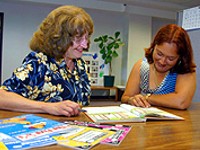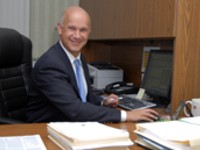[
{
"name": "500x250 Ad",
"insertPoint": "5",
"component": "15667920",
"parentWrapperClass": "",
"requiredCountToDisplay": "1"
}
]
Fall is such a funny, nostalgic time. Even those of us who don't particularly miss our school days can still fall susceptible to the classic fall-time itch: the one that makes you want to fill a backpack with new pencils and notebooks and go wait for the school bus. Maybe it's the itch for new beginnings. (And if we'd paid attention in Psych 101, maybe we'd know.)
But here's a news flash for all you post-school adults: There is a whole smorgasbord of electives out there that don't require coming down with bubonic plague sometime around midterms. No homework, no tests, and no number two pencils. You can learn about that one quirky thing you've always found intriguing. (Balloon sculpting, anyone?) Or, learn a utilitarian task just for the chance to brag to your favorite know-it-all: "Oh, you never learned how to install recessed lighting? How funny. I mastered it long ago." Now does that sound fun? You bet. Go ahead and scratch that itch: It's time to go back to school.
From shower to stage
Calling everyone who holds secret visions of stardom when they are singing in the shower or in the car: Patricia Alexander hasn't met an amateur voice she couldn't work with.
"You never know," she says. "You never know. I believe in everybody." A particularly kind quality for a voice teacher, perhaps. But according to Alexander, "very, very, very few" people are actually tone deaf. So take heart, closet singers.
Alexander has been teaching voice for over 25 years. She was the first voice teacher for her daughter, renowned soprano Renée Fleming. She now teaches full time through Eastman's Continuing Education Division, a task that includes teaching private students and a class of adult singers, which she took on last year. Her first class had a wide range of students: a lawyer, a retired nurse, a medical student, a chemical engineer who just wanted to be able to sing church hymns. And their singing abilities filled a wide range, as well. Some had never, ever sung before.
She taught all the students breathing, tone placement, how to read music, and took them through her proven repertoire of folk, classical, and musical theater songs. The class was "so supportive," Alexander says. "They encouraged, they complimented." By the end, every student was confident enough to sing a solo in the class recital. With Alexander's help, could you be the next Renée Fleming? You just never know.
Voice Class for Adults is offered through the Eastman School of Music's Continuing Education Division, 26 Gibbs Street. Private lessons with a number of voice teachers are also available. Cost: $248. 274-1400, www.rochester.edu/Eastman/ced/
Floating on air
"The balloon is my paintbrush," says balloon artist Larry Moss. He's been performing with balloons since 1985 and has been a full-time balloon artist since 1995, so he's had time to think about metaphors to explain his unconventional vocation.
"People ask me 'How can you get respect for an art that doesn't last?' I like to compare it to sand art and ice sculpture," he says. "I teach people to create memories."
You might call Moss a balloon pioneer. He is the artist behind the giant orange octopus seen flying over the Great Sodus Bay Screen Family Fest in July. It was a piloted, 20,000-balloon sculpture that took Moss and his assistant five days to build.
But Moss starts the students in his Airagami classes out a little smaller. They learn to make cats and dogs then move on to larger creations, like portraits. He likes his students to learn how to be creative with their balloons.
"Rather than me giving recipes, people end up walking out knowing how to use balloons as a medium," he says. His students have included professional clowns, high school students, and, once, the staff of the Jefferson Road post office.
Airagami with Larry Moss is offered through Rush-Henrietta Continuing Education, 1799 Lehigh Station Road, Henrietta. Pre-registration is required. Cost: $75. Info: 359-7805.
Ragtime on the recorder
You may remember recorders from elementary school music class. They were probably lumped together in the box with the castanets, tambourines, and other abused instruments deemed appropriate for children. Frank Amato, a retired chemist and president of the Rochester chapter of the American Recorder Society, wants to set the record straight.
"People think of it as a simple instrument," he says, "but I've played very demanding music on the recorder." He's played music from the 1300s and 1400s --- the recorder's heyday --- as well as classical pieces and even ragtime, depending on his audience. The recorder's structure is simple: It has a whistle-like mouthpiece and a body with seven or so holes that players cover and uncover with their fingers to make music. But Amato says that with the deceptively simple recorder you can play the equivalent of any of the parts in a string quartet.
Amato played clarinet and saxophone through high school, college, and his time in the Navy. But when he went back to music, he went back to the recorder, an instrument that doesn't require the same muscle strength of other wind instruments and one on which it is easy to learn the fundamentals.
He, along with other chapter members in the 45-person group, volunteers during regular chapter meetings to teach newcomers and beginners. Some of these people have been playing for years, some even have music degrees and can teach beginner through advanced intermediate levels. Anyone with an interest is welcome.
The Rochester Chapter of the American Recorder Society meets twice a month from September through May. There is a yearly membership fee. There will be a registration meeting on Tuesday, September 9, at the Lutheran Church of the Incarnate Word, 597 East Avenue, 7:30 p.m. 225-6808.
I'll toast to that
The international organization of Toastmasters was created to help people become comfortable with public speaking. But to the timid, Linda Penniston, president of the Life Learners Toastmasters, promises that guests "don't have to open their mouth if they don't want to."
There are 15-plus Toastmaster groups in Rochester, with at least one group meeting every day of the week. Most are open to new members. All the clubs follow the guidelines set by the international organization. There are manuals, roles for everyone to play during the meetings, and fixed agendas. Beginners are assigned a mentor who guides them through their first three speeches. Other benefits of membership, Penniston says, are leadership skills, learning how to take constructive feedback, and how to sound polished when talking off the cuff. You'll get feedback on every speech, and it is always in the sandwich approach: something nice, suggestions for improvement, something nice again. Humiliation is not on the program.
The Life Learners Toastmasters meet on the first and third Saturdays of the month at 2011 East Main Street, at 5 p.m. 385-6417, www.lifelearners.org. To find another Toastmasters group, go to www.toastmasters.org.
Talking to the divine
Charlene Hacker got her first deck of Tarot Cards for her 13th Christmas. She thought they were something electronic because she could feel them vibrating through the wrapping paper. She gave her first reading to her grandmother, predicting a new husband and more children. To her family's laughter, Hacker put the cards away. But when her grandmother several years later married a man with children, she pulled those cards right back out.
Hacker now runs Psychic's Thyme, a bookstore and learning center specializing in New Age arts. She teaches a number of classes, including how to read Tarot Cards. A Tarot reading, according to Hacker, is 75 to 80 percent accurate, if not more. But it depends on the reader and how well they know and feel comfortable with their deck.
"You have to let the information flow through you, and learn to trust your intuition," she says. Where does the information come from? "From spirit, from divine," she says. "That realm you go to when you're dreaming." The cards tell people about their past, present, and can help steer people away from negative events in the future.
"Forewarned is forearmed, as my mother used to say," Hacker says. Prosaic advice from a woman who talks to spirits.
Tarot Card Reading is taught at Psychic's Thyme, 16 Edmonds Street. For a schedule call 473-4230 or visit www.psychicsthyme.com
Cut a rug village-style
"Folk dancing is something that is truly for folks. In villages... you would see anything from little children... to grandparents," says Alene Boyar, one of three teacher-dancers with the International Folk Dancers. Boyar has been dancing since 1968, and she can't remember when she started teaching.
The International Folk Dancers get together to learn and practice Balkan, Eastern European, and some Scandinavian and Israeli folk dances. There are line dances, circle dances, couple dances, and even a couple of square dances. No one needs to be very athletic or coordinated to participate in at least part of the evening: dances range from "incredibly easy to incredibly difficult," Boyar says.
Teaching is concentrated at the beginning of the evening, and as the night progresses people can request some of their favorite dances. But the teachers will re-teach dances on request.
The International Folk Dancers meet twice a month, on various Fridays, at the Friends Meeting House, 84 Scio Street. Call 377-1805, 461-9266, or 244-4572 for a fall schedule. The International Folk Dance Club of Rochester, a group with some overlap with the Friday group, meets on Monday evenings. Call 624-1964 for times and location.
Test drive that cordless drill
According to John Rutigliano, assistant manager at Home Depot, the free how-to clinics at the store are hands-on enough and give people enough opportunities to practice, to "make it all seem possible, make it worthwhile, and like something you can do."
The how-to clinics were so good they were what lured Rutigliano, a self-professed computer guy, into a job with the store.
"You really walk out with great, specific suggestions, and you actually get to try the tools on our dime," he says.
The clinics cover everything from sealing a driveway to laying a ceramic floor to installing ceiling fans. They're free, and people can give the tools and techniques a whirl before going home because, as Rutigliano points out, seeing something on a shelf and actually using it are two very different things.
How-to Clinics at Home Depot, 770 Jefferson Road. Evening and weekend classes are scheduled on a monthly basis. 427-0390.
Sporting with glass
"Glass blowing is more like a sport," says Elizabeth Lyons, director of the More Fire Glass Studio. "You learn the techniques and then you practice. The art part of it comes after."
Lyons and other instructors at the studio teach five levels of glass blowing. In beginners' classes students make their own glass tumblers and can eventually --- in the next levels --- move up to creating sculptures and decorative pieces. Other workshops include beadmaking, a class that is nearly always full, and special workshops with visiting glass artists.
Though working with hot glass can seem intimidating to the uninitiated, according to Lyons the beginning classes really, truly require no experience.
"We love beginners," she says. The only thing you need is a real desire to learn.
Glassblowing at More Fire Glass Studio, 80 Rockwood Place. Cost: $220. 242-0450, www.morefireglass.com.
Be a Good Samaritan
"Most of us at some point in our lives will witness someone having an emergency. And most of us will want to help," says Sally Wade, director for health, safety, and community volunteer services at the Greater Rochester Chapter of the Red Cross. When you realize how many CPR (Cardiopulmonary Resuscitation) courses the Red Cross offers, at how many different times of day, and finally, that you can learn CPR in three-and-a-half hours, there seem to be no more excuses.
Don't forget the gosh-darned usefulness of it all. In CPR classes you learn how to recognize an emergency, when to call 911, and what to do if someone is choking or needs you to breath for them. You can learn CPR for adults, for children and infants, or for all three. Then there's CPR-AED, where, in addition to CPR training, you can learn how to operate an Automated External Defibrillator (those machines that TV doctors are always using after they yell 'clear!'), which are starting to show up everywhere from airplanes to conference rooms.
CPR training at the Rochester Chapter of the Red Cross, 50 Prince Street. Cost: $45. 241-4453, www.rochesterredcross.org.
Drive like you mean it
Jim McGrath, owner of Jim Terry's Driving School, just wants to bring the driving public up to speed. He estimates that 99.5 percent of people think they are good drivers. So why do all the accidents happen?
"You can think you're a good driver, but it could be that everyone else is watching out for you," he says. They'll be watching out if they took a defensive driving course, anyway.
The course at Jim Terry teaches people simple techniques to drive more safely, alerts them to changes in the driving laws, and refreshes the things they learned in driving school all those years ago. One six-hour course knocks 10 percent off your insurance costs for three years and reduces your driving record by four points.
According to McGrath, after taking defensive driving, 80 percent of people think everyone should take it. And McGrath agrees: There's no shame in driving on the safe side of the road.
"Defensive driving is about driving safely," McGrath says. "It's not about driving three miles an hour. That's just frustrating for everybody."
Defensive Driving is taught the third Saturday of the month at Jim Terry's Driving School, 1225 Norton Street. Cost: $40. 266-1381.
In This Guide...
Latest in Continuing Education
More by Erica Curtis
-
What's in the water?
Jun 14, 2006 -

Roses are red
May 3, 2006 -

As American as pasta e fagiole
Mar 22, 2006 - More »






